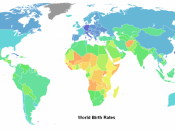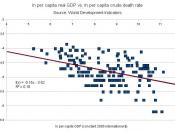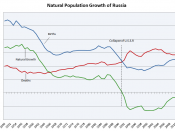This research paper will focus on the demographics of Mexico which "Borders immediately south of the United States, in-between the USA and Central America. Mexico is classed as a member of Latin American nations, and is part of the North American Continent" (http://www.mexperience.co.uk/discover/discov_ff.htm) Demographics can be defined as the characteristics of the people which reside in that particular area, more specifically this paper will discuss the country's population, birth and death rates, immigration and emigration activities, age distribution and population growth rates. In addition this paper will discuss the factors which may play a role in determining the country's population.
Mexico's population is currently 111,211,789 (Theodora, 2010, ö 1). This is in contrast to their population in 1950 where there were approximately 30,000,000 people.
The following chart contrasts the population growth between Mexico and Canada.
Population is an important area of study to ensure there are not too many or too few people.
The carrying capacity of an environment is the maximum number of individuals that it can sustain, and this amount stays steady, whereas a population tends to increase exponentially. It is estimated that the worlds population will increase from approximately 6 billion people today, to over 9 billion people by 2050 (Columbia University, 2005, figure 2). There are 4 stages of demographic development according to Columbia University. These are:
Stage 1 - Pre-Industrial stage. In this stage little population growth is realized due to harsh social conditions that lead to both high birth and death rates.
Stage 2 - Transitional stage. In this stage industrialization begins and health care improves. This leads to a reduction in death rates, but birth rates remain high. Most of the developing world is currently in this stage.
Stage 3 - Industrial stage. In this stage birth rates decline due...


